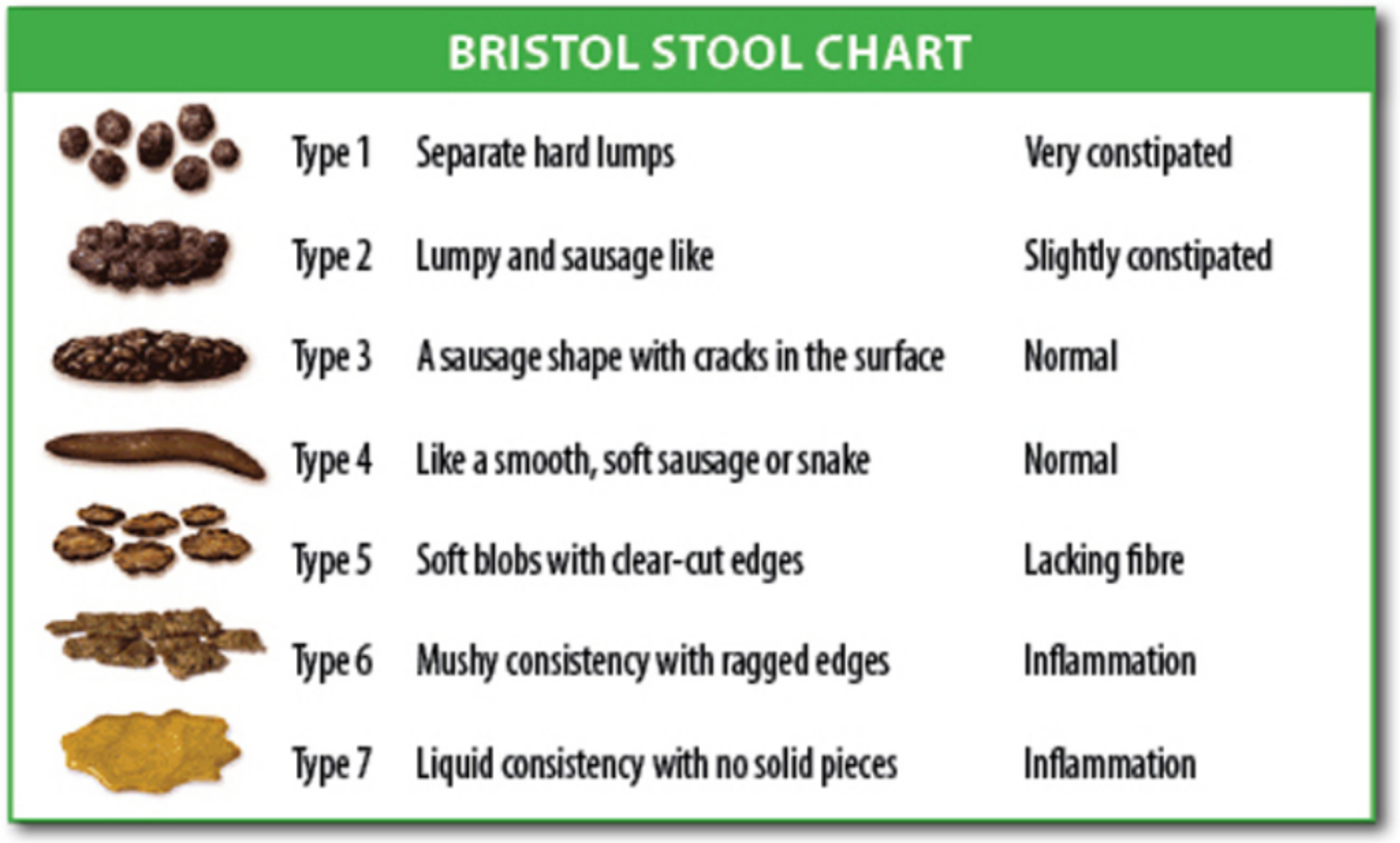If you’ve never heard of the Bristol Stool Chart, you may not know that there are actually several different types of poop. And while discussing your pooing habits might be taboo, sometimes it’s necessary for your wellbeing.
The Bristol Stool Chart, also referred to as the Bristol Stool Scale or the Meyers Scale, can make it a lot easier to describe your bowel movements (and find out if they’re healthy or not) to your doctor. It comes in handy if you experience any kind of digestive or gut health issues, like IBS, and can help your doctor properly diagnose your symptoms or condition.
“Your bowel movements are the only real marker you have about what your GI health is like,” says gastroenterologist Dr Anish Sheth. Getting familiar with what’s normal for you in terms of stool shape, consistency, and texture can help you better take care of your body and pick up on any changes that may signal a bigger problem.
If something is off with your digestive health, being able to reference the Bristol Stool Chart ensures that both you and your doctor are on the same page about what, exactly, is landing in the toilet, without having to bring in a stool sample. Here’s what you need to know about this handy reference guide, and what your poo says about your health.
What is the Bristol Stool Chart?
The Bristol Stool Chart is a visual guide to the different types of poop you can have. “We use it to classify stools and the character of stools,” says gastroenterologist Dr Rudolph Bedford.
The chart breaks poo down into seven different types based on consistency, “from hard and pellet-like to soft and mushy,” says gastroenterologist Dr Randall Meisner. “It describes a wide variety of what are considered normal bowel movements,” he adds.
The types of stool are:
- Type 1: Separate, hard lumps
- Type 2: Lumpy and sausage-shaped
- Type 3: Sausage-shaped with cracks
- Type 4: Sausage-shaped, smooth, and soft
- Type 5: Soft blobs with clear-cut edges
- Type 6: Mushy pieces with ragged edges
- Type 7: Liquid consistency
How is poo classified in the Bristol Stool Chart?
Under the Bristol Stool Chart, poo is classified into seven distinct categories. Here’s a breakdown.

1. Separate lumps
Hard poo will often come out in separate lumps and can be painful to pass. When poo is this texture (similar to pebbles), it’s a sign that it sat in the large intestine and colon for an extended period of time. In other words, this type of stool often signals that you’re constipated.
If this is commonly what you see in the toilet (and you aren’t suffering from another illness that comes with this side effect) you may have a gastrointestinal condition called chronic idiopathic constipation, or CIC. Drinking more water, making exercise part of your daily routine, and slowly adding more fibre to your diet are all things that can help.
2. Sausage-shaped but lumpy
Firm stools that are connected but still lumpy can also be a sign of constipation. This signals that your waste has hung around in the intestine long enough to become dried out, but not so long that it’s dry enough to break into smaller pieces.
You can try eating more foods that are known to relieve constipation to get things moving, but if nothing seems to help, ask your doctor if a prescription medication is right for you.
3. Sausage-shaped with cracks
If this describes what you’re used to seeing when you go to the bathroom, then congrats! This is considered to be a healthy stool, according to the Bristol Stool Chart, a tool used by medical professionals and dietitians.
The cracks, however, do indicate that you may be a bit dehydrated. Gastroenterologist Dr Robyn Karlstadt suggests drinking six to eight glasses of water daily to keep your GI health in tip-top shape.
4. Sausage-shaped, smooth, and soft
Doctors consider this type of stool (think: sausage- or snake-shaped) to be the gold standard, especially when it’s also medium to light brown in colour and remains intact as it is flushed. If this is what your poop looks like, give yourself a pat on the back because it’s a clear sign you’re eating a wholesome diet and staying nice and hydrated.
5. Soft blobs with clear-cut edges
This is considered to be a slightly loose stool, but it’s fairly common for folks who have bowel movements two or three times a day, typically after eating a main meal. (If this is normal for you, and it’s soft and passes comfortably, consider it A-OK.)
6. Fuzzy or fluffy pieces with ragged edges
When waste passes through the colon quickly, this texture of poop is often the result. According to the Bristol Stool Chart, fuzzy, jagged pieces may indicate inflammation of the bowel or an inflammatory bowel disease like ulcerative colitis or Crohn’s disease. It can also indicate a major change in your diet. Check with your doctor to make sure there’s no reason to be concerned.
7. Watery (liquid poop)
This advanced stage of diarrhoea occurs when the small intestine is irritated. There are numerous causes of this type of stool, including viruses and bacteria, digestive disorders, and lactose intolerance. Sometimes eating or drinking things with lots of fructose or artificial sweeteners, or starting a new medication can be the cause, according to the Mayo Clinic. If your diarrhoea lasts more than two days, contact your doctor.
How is the Bristol Stool Chart used?
The Bristol Stool Chart helps doctors and patients speak the same language when talking about bowel movements, explains gastroenterologist Dr Lukasz Kwapisz. “It really helps clinicians – in most cases, gastroenterologists or primary care physicians – to have an understanding of what type of bowel movements patients are having,” he says. “This allows the doctors to tailor a treatment plan to improve the consistency and help alleviate patients’ concerns.”
Typically, patients are shown the chart and asked to ID the number of the stool they’ve been experiencing. “It’s hard to describe poop,” points out gastroenterologist Dr Ellen Stein. “It’s a lot easier to point to [the chart].”
Your healthcare provider may use the Bristol Stool Chart if you have unusual bowel symptoms, such as diarrhoea, constipation, abdominal cramps, bloating and gas, nausea, or malabsorption. They may also ask you other questions about your stool such as:
- How much do you tend to pass with each bowel movement?
- How does your poo tend to smell and what colour are they usually?
- Do you notice blood or mucus in your poo?
- Do your stools stick to the toilet bowl after flushing?
What is the ideal stool type?
Everybody has their own stool consistency that’s considered “normal” for them. But, in general, a type 3 or 4 is best, Dr Stein says. “Four is kind of a soft serve consistency,” she explains. “It’s easy to pass and smooth. That’s considered ideal.”
Having a type 3 or 4 poop indicates that you’re well hydrated, but it’s not as liquid as diarrhoea, which suggests you’re passing things too quickly through your GI tract, Dr Stein says.
How to improve your bowel health
If you’re experiencing a stool type outside of the “normal” range, you might consider taking action to improve your digestive or bowel health.
One simple way to improve bowel health is to drink more water and add more fibre to your daily diet. “Fibre and water work together to keep things moving easily and smoothly through your digestive system,” explained dietitian Nichole Dandrea-Russert.
Adding more movement into your daily routine can also help. Think of a post-meal walk or daily yoga flow to promote digestion and regular bowel movements. But these recommendations all depend on what’s going on internally: for people with diarrhoea, more fibre isn’t always the best option. So, speak to your doctor before altering your diet or adding any fibre supplements to your regimen.
Also, if you’re taking a new medication, talk to your doctor about any changes in your stool. You may be able to change the dose or switch to a different medication to lessen the effect on your bowel habits.
When to see a doctor about your poo
Everyone’s normal bowel movements are different, and your bowel habits may change for a number of reasons, including diet, stress, travel, dehydration, medications, physical activity, illness, changes in your hormone levels and other health conditions such as inflammatory bowel disease or colon cancer. Because of this, experts say it’s tough to say for sure what type of poo should send you running for the doctor.
“A good general rule of thumb is that if there is a change in bowel habits, whether stool frequency or consistency, that is ongoing for more than a few days, this would be a good time to see your doctor to discuss,” Dr Kwapisz says.
“Red flag” symptoms include:
- Bloody poo
- Fever
- Unexplained weight loss
- Uncontrollable vomiting and diarrhoea
- Not being able to poo at all
If you experience any of these “red flag” symptoms at any time, you should see your doctor sooner rather than later, says Dr Kwapisz.








.jpg&h=193&w=250&c=1&s=1)
